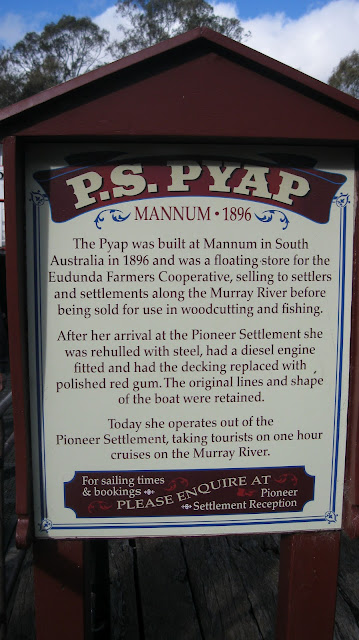Saturday 11th August
Our destination today was Mannum on the Murray River,
about 75 km from Gawler. This was not a
long drive but one which took us through some very pretty countryside and
enabled us to get out of the city and into the country regions. On the way my
eyes were diverted to a farmers market at Mt. Pleasant, so naturally we called
it a rest stop and stayed to look over the local produce. Upon entering the
hall our senses were drawn to hot cooked popcorn and tables of produce ranging from
fresh yellow beetroot to lovely dainty cupcakes.
This was a morning to enjoy chatting to the
country stallholders while sampling their wares. We came away with quite a
number of home created food items, but sadly I paid for a delicious wheel of
camembert cheese, talked too much to the stall holder and realized at the next
destination I had not picked it up when I paid for it.
When we arrived in Mannum we found a lovely camp spot
right on the Murray River, very close to the ferry where we were able to leave
the van and truck while looking over the town. We found a craft shop run by the
local hospital auxilliary which had a list of the items the shop had funded
over the past 10 years – to the tune of $500,000. I thought this was an interesting way to let
shoppers know that the purchase of that jar of jam or the fridge magnet all go
towards making life in hospital a little more bearable. Their latest purchases are 2 beds at $6000
each. What we find so uplifting in these
little shops is the enthusiasm of the volunteers running the place and their
willingness to engage in conversation.
Both sides of the Murray River at Mannum is serviced by a
punt, rather than a bridge, so we used this a number of times, both with the
vehicle and on foot. The trip is only
about 3-4 minutes, and while the locals accept this as a way of life, to us it
was a novelty.
In 1851 pastoral leases classed as
“Waste Land of the Crown” were issued
and William Beavis Randell leased 34 square miles from the present Dry Dock
area stretching eight and a half miles upstream. He gave his land the name “Noa
No”. William B. Randell's son, William Richard worked at his father's flourmill
in Gumeracha, but dreamed of building a paddle-steamer and using it to trade on
the River Murray. He, and his brother, Thomas George, together with a
carpenter, built the frame and transported it to their father's river property
by bullock cart. There, they finished it and named it the ‘Mary Ann' after
their mother. It was to become the first paddle-steamer to ply the River Murray.
To
service his growing trade, William R. Randell built the Woolshed, the first
building in Mannum. He and his brothers built houses for themselves during the
next decade, and slowly the town began to develop around this area.
It is easy to assume that Mannum, once the paddle-steamer
trade had died, would lose its attraction for local residents. The town has
re-invented itself, however, and is now a thriving tourist destination. It
boasts a thriving accommodation and houseboat industry, and is lucky to
have retained many of its original buildings in the main street named after
William Randell. We noticed the main street had agents windows displaying only
houseboats for sale.
I spent the rest of the afternoon sitting alongside the
water while intermittently reading a book, watching a little girl trying to
catch yabbies and enjoying the day to day activities of the water craft.








































